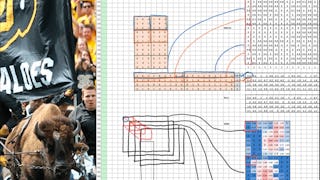Introduction to Computer Vision guides learners through the essential algorithms and methods to help computers 'see' and interpret visual data. You will first learn the core concepts and techniques that have been traditionally used to analyze images. Then, you will learn modern deep learning methods, such as neural networks and specific models designed for image recognition, and how it can be used to perform more complex tasks like object detection and image segmentation. Additionally, you will learn the creation and impact of AI-generated images and videos, exploring the ethical considerations of such technology.


Introduction to Computer Vision
This course is part of Computer Vision Specialization

Instructor: Tom Yeh
3,546 already enrolled
Included with
(20 reviews)
Recommended experience
What you'll learn
Understand the fundamental principles and algorithms of classical computer vision.
Apply deep learning models to various computer vision tasks.
Evaluate and implement computer vision solutions for real-world applications.
Skills you'll gain
Details to know

Add to your LinkedIn profile
23 assignments
See how employees at top companies are mastering in-demand skills

Build your subject-matter expertise
- Learn new concepts from industry experts
- Gain a foundational understanding of a subject or tool
- Develop job-relevant skills with hands-on projects
- Earn a shareable career certificate

There are 4 modules in this course
Welcome to Introduction to Computer Vision, the first course in the Computer Vision specialization. In this first module, you'll be introduced to how this course operates "by Hand" and "in Excel." Then, you'll build a foundation in image matrices and arrays to explore different image types: binary, grayscale, and RGB. Next, you'll transition into using functions to perform basic image operations such as addition, negation, and masking. You'll then be introduced to the concept of image transformation through linear algebra. Finally, you'll perform translation, scaling, and rotation matrix operations.
What's included
34 videos8 readings8 assignments
This module dives into feature extraction—quantitative measures that describe image content. Students compute features such as image mass, center, and statistical moments to describe the shape and structure of images. These are implemented both manually and in Excel. The module also explores how to compare images using distance metrics and similarity measures, offering insight into how visual data can be analyzed, categorized, and classified.
What's included
23 videos2 readings5 assignments
Filtering techniques are central to detecting patterns in images. This module introduces learners to 1D and 2D filters, covering foundational concepts like convolution, cross-correlation, and Gaussian smoothing. Through both manual and spreadsheet-based exercises, learners apply various filters (e.g., mean, Laplacian, Sobel) and morphological operations like dilation and erosion. These filtering methods enhance image features, detect edges, and prepare data for further processing.
What's included
26 videos2 readings5 assignments
This module delves into key concepts of camera models and their role in computer vision and photogrammetry. You will learn about the Extrinsic Matrix, exploring how it defines the position and orientation of a camera in 3D space. Understand the Pinhole Camera Model, a simplified optical system that forms the basis for many computer vision applications, alongside the Intrinsic Matrix, which captures the internal parameters of the camera. Epipolar geometry is examined, with a focus on its significance in 3D reconstruction and stereo vision. The module covers the motivation behind epipolar geometry, breaking down its basic components, and explaining the Essential Matrix, which encapsulates the geometric relationship between camera views, as well as the Fundamental Matrix, a core component in epipolar geometry that represents the relationship between two cameras in stereo vision.
What's included
15 videos3 readings5 assignments
Earn a career certificate
Add this credential to your LinkedIn profile, resume, or CV. Share it on social media and in your performance review.
Build toward a degree
This course is part of the following degree program(s) offered by University of Colorado Boulder. If you are admitted and enroll, your completed coursework may count toward your degree learning and your progress can transfer with you.¹
Instructor

Offered by
Explore more from Algorithms
 Status: Free Trial
Status: Free TrialMathWorks
 Status: Free Trial
Status: Free Trial Status: Free Trial
Status: Free TrialUniversity of Colorado Boulder
Why people choose Coursera for their career





Open new doors with Coursera Plus
Unlimited access to 10,000+ world-class courses, hands-on projects, and job-ready certificate programs - all included in your subscription
Advance your career with an online degree
Earn a degree from world-class universities - 100% online
Join over 3,400 global companies that choose Coursera for Business
Upskill your employees to excel in the digital economy
Frequently asked questions
To access the course materials, assignments and to earn a Certificate, you will need to purchase the Certificate experience when you enroll in a course. You can try a Free Trial instead, or apply for Financial Aid. The course may offer 'Full Course, No Certificate' instead. This option lets you see all course materials, submit required assessments, and get a final grade. This also means that you will not be able to purchase a Certificate experience.
When you enroll in the course, you get access to all of the courses in the Specialization, and you earn a certificate when you complete the work. Your electronic Certificate will be added to your Accomplishments page - from there, you can print your Certificate or add it to your LinkedIn profile.
Yes. In select learning programs, you can apply for financial aid or a scholarship if you can’t afford the enrollment fee. If fin aid or scholarship is available for your learning program selection, you’ll find a link to apply on the description page.
More questions
Financial aid available,


